It follows on from our previous blog exploring prehistory to the Romans.
Anglo-Saxons and Vikings
In the 5th century AD central Roman rule collapsed and Britain dropped out of the Roman empire. Small kingdoms began to emerge in Britain.In the Wakefield area the British kingdom of Elmet formed. In turn this was taken over by the Anglo-Saxon kingdom of Northumbria.
Very few objects survive locally from the Anglo-Saxon and then Viking periods. This makes what we do have even more special!
We have these two spearheads in Pontefract Museum:
It dates to the 9th century AD, and was found being used as a doorstep in a shop on Westgate 1000 years later!
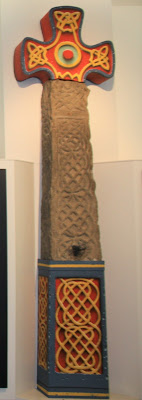 |
| The Anglo-Saxon cross shaft at Wakefield Museum, completed with reconstructions of the base and cross. These would have been painted in bold colours. |
The most spectacular Viking find from our area is the Stanley Ferry Viking log boat. This is on display in Wakefield Library, kindly lent by York Museums Trust.
 |
| The Stanley Ferry Log Boat at Wakefield Library |
The Norman Conquest
The Anglo-Saxon and Viking periods in Yorkshire ended with the Norman invasion of 1066 by William the Conqueror.Although we don’t have many objects from the Norman period, we do have two awesome places where their legacy can be seen: Pontefract Castle and Sandal Castle.
The standing stone remains at both these sites today are the reinforced replacements for the original Norman wooden buildings.
These castles were key to turning William’s
battlefield victory at Hastings into long-lasting conquest. They maintained
dominance over the strategic landscape and the everyday life of local
residents.
 |
| Sandal Castle, probably built in the 12th century by the de Warenne family. |
The Normans didn’t just build castles, however. They also built religious houses such as St John’s Priory in Pontefract.
When this site was excavated in the 1950s and 1960s, some of the most interesting finds came from graves in and around the church.
This small cross was found around the neck of its owner. It is made of jet (the fossilised wood of the monkey puzzle tree), which was likely washed up on the beaches near Whitby.
This small cross was found around the neck of its owner. It is made of jet (the fossilised wood of the monkey puzzle tree), which was likely washed up on the beaches near Whitby.
 |
| The jet cross found at St John's Priory, Pontefract |
You can see it for yourself at Pontefract Museum! It also features in the 100 Years of Collecting Online Exhibition.
Lost and Found
Most archaeological finds weren't originally as carefully placed in the ground.Many were lost, like this spear head, which was found in the Portobello estate near Sandal Castle. It was probably left behind during the bloody Battle of Wakefield in 1460.
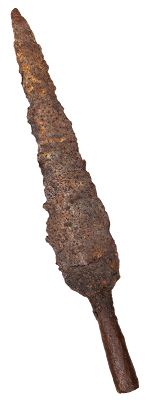 |
| An iron spearhead, probably from the Battle of Wakefield in 1460 |
Other items
were broken and thrown away, like these pottery fragments.
 |
| Pottery fragments found at Sandal Castle |
Although these fragments may not look impressive at first, when reassembled they from a portable urinal decorated with a boar’s head!
Given that they were found at the Yorkist stronghold of Sandal Castle, and the boar was a symbol of Yorkist king Richard III - could it be that this was actually used for the ‘royal wee’?
 |
| We carefully put the boar’s head decoration back together from its pieces. It is displayed alongside a replica of the urinal at Wakefield Museum. |
We don’t know where the urinal was made but only a few miles away a major pottery industry was just beginning.
Pottery making in Wrenthorpe became so important that the village became known as ‘Potovens’ after the kilns the pots were fired in.
Wrenthorpe pottery was distinctive, with dark colours and shiny glazes. This jug is a prime example! It was also found during excavations at Sandal Castle.
Wrenthorpe pottery was distinctive, with dark colours and shiny glazes. This jug is a prime example! It was also found during excavations at Sandal Castle.
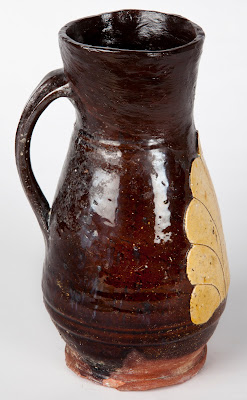 |
| A Wrenthorpe jug, on display at Wakefield Museum and in the 100 Years of Collecting Online Exhibition |
The English Civil Wars
The Ackworth Hoard consists of nearly 600 gold and silver coins, all buried in a Wrenthorpe pot, along with a gold ring.
 |
| The Ackworth Hoard |
It was buried in the chaos of the Civil Wars during the siege of Pontefract Castle in the 17th century. It had probably belonged to a Royalist supporter, who wanted to prevent it from being taken by the Parliamentary troops billeted in Ackworth. For whatever reason, the person who buried it was unable to come back and retrieve it.
The coins in the Ackworth Hoard were worth £85 and 12 shillings. This was a lot of money - around 7 years’ pay for a foot soldier during the Civil Wars.
The hoard remained untouched in the pot for over 350 years – until it was discovered in someone’s garden in the 20th century!
The hoard remained untouched in the pot for over 350 years – until it was discovered in someone’s garden in the 20th century!
You can see it for yourself on display at Pontefract Museum.
Even in the middle of a siege, the soldiers in Pontefract Castle needed paying. Being cut off from the outside world made this difficult. Their answer was to create their own home-made coins from reused silver.
The silver would come from luxury tableware and candle-holders owned by the richest members of the garrison. The silver objects were cut up or melted down and reshaped. The 'siege coins' were then cut from the resulting silver sheet.
You’ll notice that siege coins aren't circular in shape like ordinary coins. This is because it was much easier to cut a straight edge than a curved one!
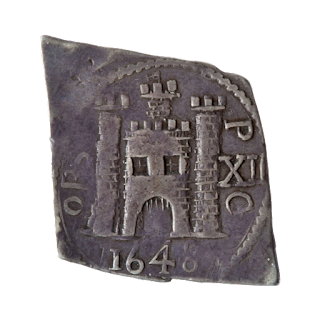 |
| One of the siege coins produced at Pontefract Castle |
This example of a Pontefract Castle siege coin is in the Online Exhibition and on display in the Visitor Centre at Pontefract Castle.
It has a standard design for these siege coins featuring an image representing the castle itself. It includes the year it was created and the Castle was under siege - 1648.
It also has a morale boosting inscription, which translates as "while I breathe I hope".
 |
| Reverse side of the siege coin, featuring Charles I's royal cipher. |
That brings us to the end of our amazing archaeology 100 Years of Collecting highlights!
There’s lots more objects exploring the many and varied stories of the Wakefield district in our Online Exhibition.
More 100 Years of Collecting blogs:
Amazing Archaeology (Prehistoric to Romans)100 Years and Counting
Wakefield’s Sporting Heritage
A trip to the Seaside


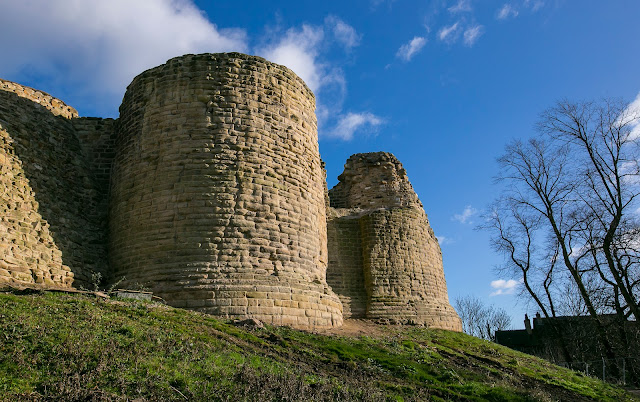
No comments:
Post a Comment
We would love your comments - though they may take a day or two to appear.